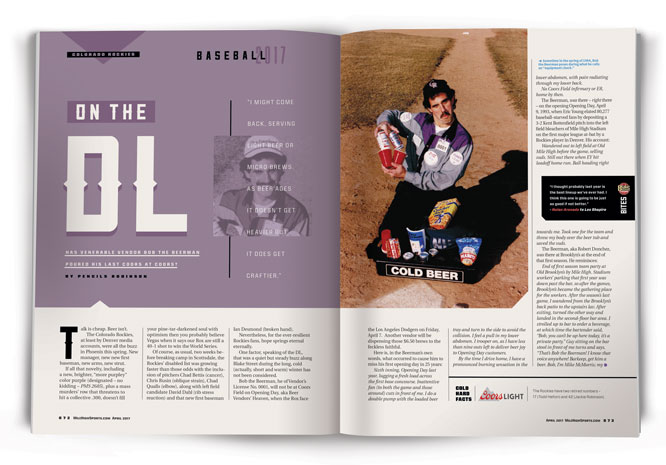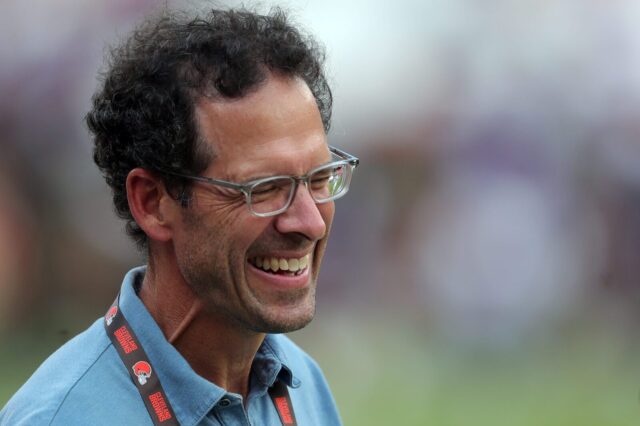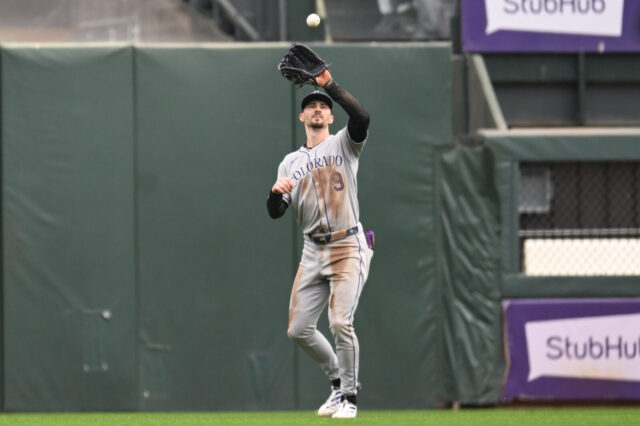This story originally appeared in Mile High Sports Magazine. Read the full digital edition.
Talk is cheap. Beer isn’t.
The Colorado Rockies, at least by Denver media accounts, were all the buzz in Phoenix this spring. New manager, new new first baseman, new arms, new strut.
If all that novelty, including a new, brighter, “more purpley” color purple (designated – no kidding – PMS 2865), plus a mass murders’ row that threatens to hit a collective .300, doesn’t fill your pine-tar-darkened soul with optimism then you probably believe Vegas when it says our Rox are still a 40-1 shot to win the World Series.
But for most Rockies fans, hope springs eternal eternally.
One factor, though, that was a quiet but steady buzz along Blake Street during the long, cold (actually, short and warm) winter has not been considered.
Bob the Beerman, he of Vendor’s License No. 0001, was not at Coors Field on Opening Day, aka Beer Vendors’ Heaven, when the Rox faced the Los Angeles Dodgers on Friday, April 7. Another vendor dispensed those $7.50 brews to the feckless faithful.
Here is, in the Beerman’s own words, what occurred to cause him to miss his first Opening Day in 25 years:
Sixth inning, Opening Day last year, lugging a fresh load across the first base concourse. Inattentive fan (to both the game and those around) cuts in front of me. I do a double pump with the loaded beer tray and turn to the side to avoid the collision. I feel a pull in my lower abdomen. I trooper on, as I have less than nine outs left to deliver beer joy to Opening Day customers.
By the time I drive home, I have a pronounced burning sensation in the lower abdomen, with pain radiating through my lower back.
No Coors Field infirmary or ER, home by then.
The Beerman, was there – right there – on the opening Opening Day, April 9, 1993, when Eric Young elated 80,277 baseball-starved fans by depositing a 3-2 Kent Bottenfield pitch into the left field bleachers of Mile High Stadium on the first major league at-bat in Denver by a member of the home team. His account:
Wandered out to left field at Old Mile High before the game, selling suds. Still out there when EY hit leadoff homerun. Ball heading right towards me. Took one for the team and threw my body over the beer tub and saved the suds.
The Beerman, aka Robert Donchez, was there at Brooklyn’s at the end of that first season. He reminisces:
End of first season team party at Old Brooklyn’s by Mile High. Stadium workers’ parking that first year was down past the bar, so after the games, Brooklyn’s became the gathering place for the workers. After the season’s last game, I wandered from the Brooklyn’s back patio to the upstairs lav. After exiting, turned the other way and landed in the second-floor bar area. I strolled up to bar to order a beverage, at which time the bartender said, “Bob, you can’t be up here today, it’s a private party.” Guy sitting on the bar stool in front of me turns and says, “That’s Bob the Beerman! I know that voice anywhere! Barkeep, get him a beer. Bob, I’m Mike McMorris; my dad Jerry’s the owner. You’re always welcome around the Rockies.”
Bob the Beerman, with an MBA in finance and marketing from Fordham University, has been there for 24 Opening Days, soothing the swill heads, bantering with the businessmen, charming the charlatans, cajoling the kids and lauding the ladies.
Over the years, I had come to see the Beerman as a fixture among the swells who occupied the lower level of the third base seats, a study in steadiness, a vend-while-hurt kind of guy, a developing legend in longevity, a man of Red Grange strength and stamina who ascended and descended the concrete stairs of Coors Field toting 60 pounds of beer and ice as if it weighed no more than a rosin bag.
I envisioned him as man who never read “Death of a Salesman,” not because it was beyond his intellectual grasp but because he could not fathom the concept. A vendor celebrates Willie Mays, not Willie Loman. A salesman never dies. He may disappear in the bottom of the seventh, but he is reborn with the first pitch the next day. Every day.
Donchez, a Senior Instructor of Finance at CU Boulder’s Leeds School of Business and Director of Business of Sports Program – while he never made the claim himself – might have been approaching Cal Ripken’s consecutive game streak of 2,632. Theoretically at least, he sold suds for 81 games a year for 23 years, or 1,863 games. Giving him credit for Opening Day 2016, he needed only 769 straight games over the next ten or so years to surpass ol’ Cal. Hell, he would be just reaching his prime well south of 60-years old. As they still say at Fenway Park (or the Mayan Theater on Broadway), “We sell popcorn older than that.”
Bob, now an author of A View from the Stands: A Season with Bob the Beerman, was at Coors Field for every game of Larry Walker’s (the most-talented Rockie ever) MVP season of 1997 (.366, 49 dingers, 130 RBIs, third of seven Gold Gloves). His favorite Larry Walker story:
In the early days of Coors Field, LoDo really rocked – few places more so than Jackson’s Hole after games. After one midweek afternoon game, Larry Walker shows up there in a short-sleeved shirt and golf cap, along with some of the Rox’ senior management. Walker asks one of Jackson’s owners if he could buy the beer trough by the front door and distribute to unsuspecting patrons as they entered. Larry plopped down the money, and then the fun began. Turning his ball cap around and serving cold ones from behind the ice-filled beer trough, with the Rox management team standing off to the side, Larry engaged the customers as he handed out the free drinks. Seeing the person in front of him get a free beer upon entering, one of the more unsuspecting people asked for one also, not realizing who was serving them. Larry said, “Sure. Were you over at the game today?”
The gentleman replied, “Sure was, and had great seats from my boss, four rows behind home plate. How about you, ever get to the games?”
Walker deadpanned, “I’m over there almost every day. But my boss sticks me out in right field.”
Walking away, the customer replied, “That’s too bad, you should really try them behind home plate.”
As Walker bit his tongue, the Rox execs rolled in laughter.
The Beerman, now married and with three kids, was there for the Miracle of 2007: The Streak, the Holliday phantom tag of home plate, the sweeps of the Phillies and the Diamondbacks. And the beer flowed like champagne. What he remembers most about The Streak:
My little boy was born right at the beginning of the streak. No, we didn’t name him Rocky.
The Venerable Vendor, once named one of “Denver’s 30 Most Eligible Singles,” was there throughout Todd Helton’s flirtation with a .400 season batting average. Helton surpassed .400 on Aug. 21 in Atlanta (the latest anyone had eclipsed the magical milestone since George Brett did so on Sept. 4, 1980), but finished the 2000 season at a National League best .372. But the Beerman, who “watches” the game with his back to the field, best remembers the Toddfather for a defensive play:
Todd Helton’s guile around the first base bag gave the Rockies a phantom third out in one summer afternoon game. Selling my wares on the right field side of home plate, about six rows up from the back edge of the dugout, I saw a throw from shortstop come sailing toward first. With a fleet-afoot runner blazing down the first base line, Helton cheated off the first base bag – by about three feet – as he caught the throw from short, well off the bag, in one continuous motion, Helton just looped toward the dugout and rolled the ball onto the pitcher’s mound like he’d done a thousand times before on a last out of the inning as the ump called the batter out at first. The Rockies fans behind the dugout were in disbelief, but ecstatic. One fan quipped, “Bob, let me buy that ump a beer for the ‘homer’ call.” To which another fan responded, “Nah, with a call like that, he may have had a couple already.”
The Suds Salesman, who has worked as a broadcaster, sportswriter and investment broker, was there when Denver got to showcase Coors Field for the 1998 All-Star Game. He recalls:
At the All-Star Game, Coors Field became a celebrity enclave. The seats down low behind home plate became VIP Central. And with it came additional security to assure the famous were safe from worshipping fans. Working one aisle there, I encountered Kevin Costner. I sold a couple of beers to Costner and his guest, but low-keyed, playing dumb as to who he was. Several innings later, I was down by his seats again when a change in security ushers left Costner unprotected, at which time a stream of female fans jumped into action and sprinted down the aisle to catch a glimpse of him. Pinned down at the bottom of the aisle by the throngs of women, I look over at Costner and said, “Are you somebody famous or something? You’re killing my beer sales.” Costner looked up sheepishly and replied, “I’ve been accused by a lot of people in Hollywood of ruining movies like ‘Waterworld’, but I’ve never been accused of killing the Beerman’s sales.”
And the Hawker who can’t always escape his “respectable” identity remembers being fingered:
One early spring afternoon game, legendary Colorado State football coach Sonny Lubick was in attendance at Coors Field with his assistant coaches. Selling suds and batting the breeze with some customer seated just in front of the Fort Collins contingent, Sonny gave me the finger – the beer finger. As I wrapped up the previous transaction, Sonny wryly asked, “Hey, aren’t you the CU business professor? Tell you what, we’ll buy beer from you all day if you’ll flunk the football players.”
Of course, the Beerman was there for all the bad stuff, too. Hideo Nomo’s no-hitter against the Rox in 1996. Jim Leyland’s mail-it-in 1999 season. The Bosox’ buzzkill sweep in the 2007 Series. 17 losing seasons.
And that concourse collision on Opening Day 2016, which brings us to the here and now.
So, is this the end of the trail, the last drop in the bottle for The Beerman? The prognosis is not promising:
I have no medical clearance to return to vending. Not even clear when or if it will be granted. Been advised will need surgery. At last count, eight different doctors/specialists – constrained by the workers’ comp system – are all scratching their heads to come up with plan of action that the insurance company will sign off on.
If the Beerman, now with a kid in med school, another at an Ivy League college and the last heading to Stanford, never returns from the DL, will his absence have a beneficial or detrimental effect on our beloved (and reviled) Rockies?
More than any other sport, baseball is part of the continuum, a cog in the universe, a timeless passion that marches to its own protracted percussionist. On a random Thursday afternoon in early September, when two teams meet whose hopes no longer spring eternal, players, coaches, fans, vendors and the game itself seem to be propelled by a timeless momentum and the relentless call of the numbers that feed baseball’s insatiable appetite.
One pitch, three strikes, four balls, nine innings, 162 games. 2,632 games. A moment. A game. A season. A career. Every detail accounted for in the permanent register which records Ty Pickup’s lone plate appearance (a single for the 1918 Phillies) in the same hallowed pages with Ty Cobb’s 11,434 at-bats.
And sometimes you wonder where you fit into the continuum. If you hadn’t left your seat in the bottom of the eighth would your hero still have struck out? If the beer vendor who had been there every Opening Day for 24 years doesn’t check in and pick up his allotment of brew for this year’s opener, will the season be blessed or cursed?
Only in Colorado, would a beer vendor be the source of such speculation.



